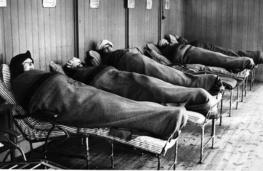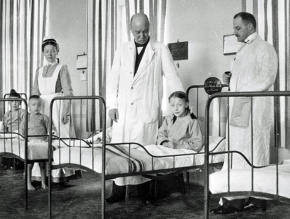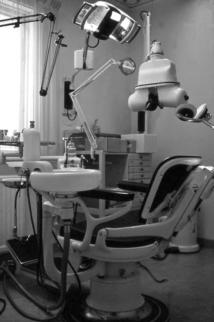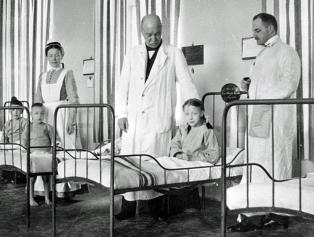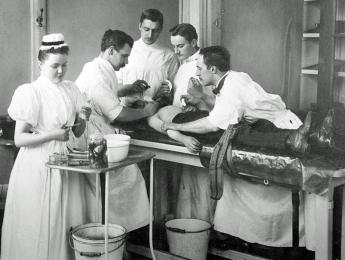

Copyright © Hans Högman 2021-09-10


History of Hospitals, Sweden
Introduction
A hospital (Swe: sjukhus) is an institution providing
primarily in-patient care as well as specialized
outpatient care. Hospitals are therefore responsible
for patients with diseases or injuries that cannot be
investigated or treated in primary care. As a rule,
outpatient care takes place in the clinics or
specialist surgeries represented at the hospital.
An older Swedish term for a hospital is “lasarett”,
which in Sweden is used synonymously with
“sjukhus”, but which originally had the meaning of
leprosy hospital or quarantine hospital.
Sweden's earliest monastic hospitals were called
“helgeandshus” or “hospital” (like in English) and
were usually a common meeting place for the poor
and crippled as well as the mentally and somatically
ill of all kinds.
The Early Hospitals
Hospitalen
“Hospitalen” (plural) were the first hospitals in
Sweden, but they were also institutions for the poor
(lunatic asylums).
They are partly of medieval origin and could be
financed by the proceeds of so-called hospital
homes, i.e. donations. In Malmö, there were
hospitals as early as 1528.
In 1553, a regulation was established for
Stockholm's helgeandshus and hospital, and it was
also applied to other Swedish hospitals. The Danvik
hospital was formed by the merger of several
poorhouses and infirmaries in Stockholm, which
had been centralized at Gråmunkeholmen in 1531.
For a long time, it was the only hospital in the city.
Note that the “hospitals” mentioned in the above
section is the Swedish meaning of the word
“hospital”, not hospitals in general.
Helgeanshus
In the Middle Ages, the combined old people's
homes, poorhouses, and hospitals run by the Order
of the Holy Spirit were called Helgeandshus, which
were an important part of the care system of the
time.
During the Middle Ages, there were Helgeandshus in
most of the cities of Europe. The first Swedish ones
appeared at the end of the 13th century.
Helgeandshuset in Stockholm was located on the
Helgeand island (Helgeandsholmen). The building
stood until around 1604 and gave the name to the
island "Helgeandsholmen".
The Helgeandshuset in Stockholm is first
mentioned in 1301, but the house is believed to
have been built a few years earlier. Stockholm's
helgeandshus was in all likelihood the second in
Sweden, built after Visby's helgeandshus (before
1288), but before Uppsala's (1302). Stockholm's
helgeandshus was located on the eastern side of
Helgeandsholmen, just inside Yttre Norrport (Outer
North gate), on the site of Riksdagshuset (the
parliament building) is today.
The Helgeandshus was designed to accommodate
two very different categories of people. One group
was wealthy elderly people, who received board,
lodging, and care until their death. For this service,
they paid a one-off sum, roughly equivalent to the
value of a stone house. The other group was the
poor and sick, who left any assets they had to
Helgeandshuset and were then cared for at the
expense of the house until their death.
In the early 16th century, the Helgeandshuset's
activities were moved to Gråbrödraklostret (a
Franciscan monastery) on Gråmunkeholmen
(today's Riddarholmen). St Göran's Hospital had
also been moved there, and together both
institutions were now called "Hospitalet". The
activities were moved to Danviken Hospital by
order of King Gustav Vasa in 1551. It was (probably)
not until 1558 that the move to Danviken took
place.
St. Göran's Hospital (Sankt Görans Hospital), also
known as Örjansgården, was a medical institution in
Stockholm, first mentioned in 1278. Örjansgården's
activities were similar in many respects to
Helgeandshuset, but with the difference that
people with leprosy were treated there until their
death, sometimes even under duress.
Danviken Hospital was built on the initiative of
King Gustav Vasa in the 16th century. The still
preserved hospital building was built in the 18th
century. From the 1740s, the hospital began to
receive mentally ill people. The hospital is
frequently mentioned in culture and in the 18th
and 19th centuries the word Danviken was used
synonymously with lunatics asylum. By the end of
the 19th century, the facility was in poor condition,
and activities were eventually moved to other
institutions.
Hospital has historically been a term for a few
different types of hospitals. The word "leprosy" has
a direct link to the word hospital or spital, where
the term "leper" referred to "the person admitted to
a hospital".
In the Middle Ages, hospitals were always referred
to as leprosy hospitals, which were usually located
outside towns. In the 16th century, it was a term
used to refer to a nursing home for the elderly, the
disabled, and the sick in general. From the 19th
century, the Swedish term “hospital” was the term
for a mental hospital.
Every city should have a hospital. For example,
Gothenburg's town privilege charter of 1621
stipulated that the city's mayor and council should
build a hospital for the poor and sick. This hospital
was inaugurated in 1627 and managed by the city
council. At the same time, the hospital parish was
established, which existed until 1883. Other
hospitals also had their own parishes.
According to the 1626 Chancellery Regulations, the
Royal Chancellery, later the Chancellery Council,
was to supervise the hospital, the house of
correction, and the orphanage. The 1642 Poor Law
Ordinance stipulated that hospitals should admit
the poor and sick who had no relatives and those
with contagious diseases. Not all towns set up
hospitals, but Skara had one in the 17th century
and the cathedral chapter decided who should be
admitted. The Ulricae Eleonorae Hospital
Foundation built the so-called Queen's House in
Stockholm for poor women in 1686.
In the 18th century, hospital activities were
separated from poor relief. After the establishment
of county hospitals (länslasarett) in the latter part of
the 18th century, only the mentally ill were
admitted to the “hospitals” (the Swedish meaning of
the term hospital). A special tax, “lasarettsmedel”,
was levied on the hospitals, later combined with a
spa charge.
General Hospitals
The oldest general hospital is the Uppsala
Academic Hospital (Uppsala University Hospital),
founded in 1708 on the initiative of Professor Lars
Roberg as a teaching hospital for the university and
called Nosocomium Academicum. In 1767, the
teaching hospital was merged with the general
hospital, but already in 1778, it was considered that
the Academy had undertaken too costly care of
county patients, so the two establishments were
separated. In 1857 they were merged again.
The next hospital was the Seraphim Hospital in
Stockholm, which was opened in 1752 and
remained in operation until 1980. The Seraphim
Hospital also had some supervision over the county
hospitals in 1787-1859/1864.
At the Seraphim Hospital, prospective provincial
physicians, city physicians, and regimental field
surgeons had to practice for six months. Midwifery
trainees were also to be taught there until the
Barnbördshuset (The Maternity Hospital) was
opened in 1775. Later, the Seraphim Hospital
became a teaching hospital for the Karolinska
Institute's (KI) medical education.
An instruction for provincial physicians was issued
on 12 April 1744 and in the subsequent instruction
of 29 July 1774 they were called "Provincial Medici".
At that time there were only 32 provincial
physicians in the whole of Sweden and all of them
were in the cities. Medical care in the countryside,
where the vast majority lived, was provided by "wise
old men and women" until well into the 19th century
when simple household remedies such as putting
on leeches and poultices would be mastered by any
housewife.
In 1765 and 1776 it was decreed that county
hospitals (Swe: Länslasarett) should be established
throughout the country, together with sanatoriums
for the venereal ill. Sanatoriums (Swe: kurhus) were
established early on in the largest cities.
As early as 1728, Gothenburg had a sanatorium
with 12 places. Stockholm first had a sanatorium at
Danvik Hospital, but from 1814 it was located in the
city. Sanatorium departments could also be set up
in general hospitals. In Gothenburg, the
Holtermanska Hospital was donated as a special
hospital for venereal diseases in 1893. The hospital
was named after a director Holterman who
donated capital in 1793 to fight venereal diseases in
the city.
Medical Care from 1862
When the county councils were introduced in each
county in Sweden through the 1862 municipal and
county reform, they were given responsibility for the
county hospitals. According to the Hospital Statute
of 18 October 1901, the county hospitals were not
allowed to receive healthy women in childbirth or
the terminally ill.
In the countryside, babies were born at home, but
in the cities, they could be born in maternity
hospitals (maternity centers). The chronically ill
would be cared for at home or in nursing homes
run by municipalities, counties, or individuals. The
Skaraborg County Nursing Home in Skövde opened
in 1898 and from 1910 received a subsidy from the
county council.
The image shows a hospital ward at Sabbatsberg
Hospital on Dalagatan, Stockholm, in 1896.
Photographer unknown. Image: Stockholm City
Museum, ID: C 1462. Stockholmskällan.
In 1922, the county councils (Landsting) were given
more explicit responsibility for health care, and in
1928 they were given full responsibility for in-
patient physical health care, i.e. county hospitals.
By that time, more than one hospital had been
established in many counties.
There were also municipal hospitals, for example
in connection with poor relief institutions in towns
or industrialized rural areas. Epidemic health care
came under the Public Health Committees
(Hälsovårdsnämnden) in rural municipalities and its
counterpart, the Health Boards (Sundhetsnämnden)
in cities.
Government Hospitals
Some general hospitals have been run by the
government, such as military hospitals. There were
medical wards in the various regiments, and
garrison hospitals were set up in places with
several regiments or units.
Stockholm's garrison hospital is the oldest, opened in
1811, but was incorporated into the Karolinska
Hospital in 1958.
There was also a hospital at the Stockholm
Squadron of the Army Fleet between 1758 and
1824 and at the Stockholm Naval Base between
1825 and 1937.
Garrison hospitals also received civilian patients, if
an agreement was made with the county council.
All garrison hospitals have been closed and their
activities were taken over by the county councils.
The Admiralty Hospital or Fleet Hospital was
located at the Karlskrona Naval Base between 1795
and 1983. War hospitals were organized during
World War II and the subsequent Cold War.
The Garrison Hospital in Stockholm opened its
doors in 1811 and was initially housed in barracks
buildings belonging to the Horse Guards. Between
1816 and 1834, a new building was constructed for
the Garrison Hospital at Hantverkargatan 45 on
Kungsholmen. Today, the former garrison hospital
building is the present Landstingshuset (Stockholm
County’s Regional Government Building).
When the new garrison hospital building was
opened in 1834, it was the largest and most
modern hospital in Scandinavia. It had 430 beds
but could accommodate 600 sick people in the
event of war or epidemics. The garrison hospital
was also responsible for training military medical
officers and other medical personnel for the armed
forces. For almost 100 years, the hospital admitted
only men who wore army uniforms. This rule was
abolished in 1933.
The hospital consisted of several large wards with
the 20s of beds. There were also wards for non-
commissioned officers, patients with infectious
diseases, and the insane, as well as a hospital
church, pharmacy, and bathing facilities. The
hospital was closed in 1969.
For the last few years, from 1952, the Garrison
Hospital was an annex to St Göran's Hospital and
served as a long-stay hospital. The building was
then rebuilt and since 1971 has been used as an
administrative building for Stockholm County
Council.
The Uppsala Academic Hospital, opened in 1708,
was government-run but initially had only 6 to 8
beds, but in the first half of the 19th century, it had
more than 50 beds. Through cooperation between
the county council, the city of Uppsala, and the
Uppsala university a new hospital was built and
opened in 1867. The new hospital contained five
wards, a maternity ward, and a spa ward and had a
total of 171 beds, of which 100 were to be at the
county council’s disposal. In 1983, the Academic
Hospital became the last in the country to be
transferred from the government to the county
council.
The Seraphim Hospital in Stockholm, originally
run by the Order of the Seraphim, was
nationalized on 1 July 1937, when it was given joint
management with the Karolinska Hospital. The
gynecological clinic of the Seraphim Hospital (1883-
1924) was linked to the Maternity Hospital in
Stockholm. On 1 July 1968, the Seraphim Hospital
was taken over by
the City of
Stockholm and on
20 January 1980,
the hospital was
closed.
The image on the
right shows an
ongoing treatment
of a patient. Interior
of the Seraphim
Hospital in 1898. Image: Wikipedia.
The current Karolinska Hospital was established
in 1940 and was a government-run hospital until
1982 when the government transferred it to
Stockholm County Council.
Mental Hospitals
In 1825, the Order of Seraphim was commissioned
by the government to inspect the country's
hospitals, where at that time only the insane were
admitted, and proposed centralization of mental
health care to the cities of Malmö, Vadstena, and
Stockholm. These three hospitals were to be
expanded and the others closed. The centralization
seems to have been carried out as well. From
Värmland province, for example, patients were sent
to Vadstena in the 1830s, but later a hospital was
added in Kristinehamn.
It was not until 1876 that the government
assumed full financial responsibility for the
country's mental health care, but government-
run hospitals existed in Vadstena from 1829,
Uppsala from 1841, Växjö 1857, Stockholm 1861,
Härnösand 1862, Gothenburg 1872, Lund 1879, etc.
These hospitals were often named after medieval
saints: St. Birgitta in Vadstena, St. Sigfrid in Växjö,
St. Lars in Lund, but Ulleråker in Uppsala.
According to the 1901 Charter of Insane Asylums,
government asylums are either hospitals (for
treatment) or asylums for patients deemed un-
treatable. In 1917, there were 9,440 beds in
Sweden; Uppsala, Lund, and Vänersborg each had
over 1,000 beds. In Jakobsberg, outside Stockholm,
there was an insane asylum between 1886 and
1896, which was under the authority of the
Stockholm City Public Health Committee
(Hälsovårdsnämnden) and was therefore municipal.
Under the Mental Hospital Act of 1929, the official
name of these hospitals was changed to
“Sinnessjukhus” (Hospitals for the insane), which was
changed to “Mentalsjukhus” (Mental hospital) in
1958. There were also municipal mental hospitals,
such as Lillhagen outside Gothenburg, which had a
special municipal mental hospital for the acutely
insane in connection with the government-run St.
Jörgen on Hisingen in 1909 - 1934.
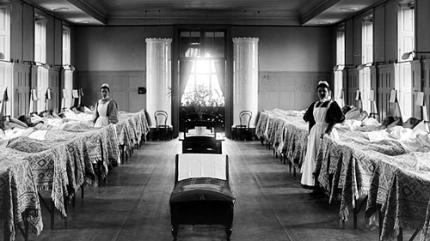
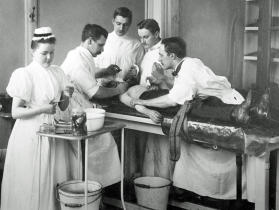
History of Swedish Hospitals
Epidemic Medical Care
Health care was perceived as a municipal
responsibility as early as the 1840s, and epidemic
care was generally municipal until 1919 and could
be under the municipal health committee until 1931,
in some cities until 1943.
Epidemic and tuberculosis hospitals became
municipal. Stockholm had about 10 temporary
cholera hospitals during the 1853 epidemic and
there was a cholera ward at Katarina Hospital
between 1853 and 1859. In 1893, a publication was
published and distributed to the provincial
physicians. It contained a plan for epidemic hospitals
for larger and smaller rural municipalities. In the
smaller ones, there were two wards and two beds in
each. But already in 1919, the county councils
(Landsting) had to take over the responsibility for
epidemic care. However, there were also earlier
epidemic committees at some county councils, such
as Älvsborg. Industrialized rural municipalities
organized epidemic hospitals as part of the poor
relief system in the early 20th century.
Gothenburg opened the first modern epidemic
hospital in 1886 and Malmö opened an epidemic
hospital in the 1880s. Stockholm's epidemic hospital
opened in 1893 which became Roslagstull Hospital
in 1945. There were also epidemic hospitals in Solna
and Vaxholm, and epidemic infirmaries in Bromma
and Sundbyberg as well as Knivsta. From 1942, there
was to be a special epidemic committee at the
county councils, but this was usually identical to the
medical committee or equivalent. Vaccines against
both tuberculosis and diphtheria from the 1940s
eliminated the most common epidemics.
The German-style sanatorium set up from the mid-
19th century, either on the coast or in coniferous
forests, where the clean air would cure the lung sick
(TB), was no longer needed when penicillin arrived.
TB was also known as the "white death" and
claimed many victims, but in 1905 the government
appointed a new commission for the control of
human tuberculosis, the Royal Tuberculosis
Committee. At the county councils, there could be a
special dispensary board for tuberculosis care, for
example at the Stockholm County Council in 1930-
1940. The City of Uppsala organized the first
municipal tuberculosis dispensary in Sweden in
1905.
A sanatorium was a type of hospital that mainly
isolated and treated patients with pulmonary
tuberculosis (TB). Based on the prevailing ideals of
care, sanatoriums were often located in places where
the climatic conditions were considered conducive to
the healing of the disease, i.e. high altitude or rural,
sea-side locations with fresh air.
In Sweden, the first sanatorium was opened in
Mörsil in 1891. Infectious tuberculosis caused the
greatest problems in the cities, and in 1910 the
largest sanatorium in Sweden, the Stockholm City
Sanatorium (later Söderby Hospital) with 440 beds,
was completed in Salem outside Stockholm. The
pulmonary clinic operated until the beginning of
1970 and then as a
long-stay clinic until
1988.
The image to the right
shows tuberculosis
patients at Söderby
Sanatorium in 1927.
Image: Wikipedia.
Another of the more impressive sanatoriums, Sävsjö
Sanatorium, can be found in Sävsjö in the Småland
Highlands. When it opened in 1907, it was the largest
in Sweden and the curved sanatorium building is still
the largest wooden building in northern Europe.
All counties built one or more sanatoriums in the
first decades of the 20th century. Sanatoriums were
phased out in the decades following World War II
when the first effective drugs were introduced. Many
of the former sanatoriums are now used for other
medical care such as long-term care or rehabilitation.
Österåsens Sanatorium was a large sanatorium in
Eds parish in Ångermanland, near the confluence of
the Ångermanälven and Faxälven rivers about nine
kilometers northwest of Sollefteå town. On 2 August
1901, the Royal Northern Lung Disease Sanatorium
was completed, and the opening ceremony was
performed by the Marshal of the Realm Fredrik von
Essen.
Österåsen was a sanatorium until 1960, when it, like
other sanatoriums in the country, was closed down
as tuberculosis care was phased out. After that, it
served as a convalescent home for allergy,
rheumatism, and asthma sufferers.
It was also common for dispensary children’s
homes to be set up where children of families with
tuberculosis infection in the home were put for a
some time to avoid infection.
A convalescent home for lung patients existed in
Eskilstuna at Odlaren between 1908 and 1921. It was
located in the forest, as forest air was considered
good for TB patients. Patients were bedded down
under a roof in large open pavilions in the forest, to
breathe in the healthy forest air.
In 1921, Södermanland County Council took over the
convalescent home to set up a dispensary children's
home there, which was named Gläntan. Children
who had tuberculosis infection at their homes lived
here for a while to avoid the risk of infection. In 1928,
the children and their bedding were moved by two
buses to Aspa children’s home in Ludgo parish,
Södermanland.
Children's Hospital
Special hospitals for children were established in
larger towns and cities in the 19th century. In 1933,
Crown Princess Lovisa's Hospital for Sick Children,
opened in 1854, was Stockholm's largest children's
hospital and was run with subsidies from the
government and the county council (Landstinget). The
Samaritan Children's Hospital (Barnsjukhuset
Samariten) in Stockholm from 1890 to 1957
continued as the New Children's Hospital (Nya
Barnsjukhuset) until 1974. Sachska Children's Hospital
1911 - 1953 was founded on donations and
continued in Södersjukhusets Children's Clinic.
Norrtull Children's Hospital 1932 - 1951 had its
origins in the General Children's Orphanage
(Allmänna Barnhuset).
Allmänna Barnhuset in Stockholm is a former
childcare facility, i.e. an orphanage. Between 1633
and 1885, the orphanage, which until 1785 was
called Stora Barnhuset, was located on
Drottninggatan/Barnhusgatan in what is now the
Barnhuset block. It then moved to Norrtullsgatan,
where it operated until 1922.
In December 1885, care at the orphanage was
moved from the old premises at Drottninggatan 73
to the new, grand building complex built between
1883 and 1885 in the Mimer block at Norrtullsgatan
14.
This was paid for by funds raised from the sale of the
former children's home and the adjacent prison's
extensive land. In time, pediatric activities at the
Allmänna Barnhuset (General Children's Orphanage)
were also expanded. Activities at the orphanage
continued until 1922.
Between 1880 and 1922, some 20,000 children were
enrolled at the General Children's Orphanage. If the
mother was unable to pay for the maintenance of
the enrolled child, she could leave it free of charge in
exchange for living at the Children's Home for eight
months and nursing her own and another child. In
addition, she would participate in the daily work of
the Children's Home (orphanage). At the beginning of
1902, 4,315 children were enrolled. At the same time,
242 children were cared for in the institution itself,
where there were also 125 wet nurses (Swe: ammor).
In 1932, the pediatric clinic at the General Children's
Orphanage was taken over by the City of
Stockholm, which set up Norrtull Hospital on its
premises. However, the General Children's
Orphanage Foundation continued its other activities.
Since the 1950s, it has focused on research and
information activities related to social childcare, with
a board appointed by the government.
Crown Princess Lovisa’s nursing home for sick
children ("Crown Princess Lovisa’s Children's Hospital")
was a children's hospital in Kungsholmen district in
Stockholm between 1854 and 1970, financed by
charity and located first at Hantverkargatan 14 and
after 1899 at Polhemsgatan 30. It was preferably for
children of poor parents.
The image to the
right shows a
hospital ward at
Crown Princess
Lovisa's
Children’s
Hospital in 1918.
In the sickbeds are
children and some
of the children are
lying in so-called “free beds”, which are marked with
an oval sign on the headboard of the bed. The staff
is, from left, Sophia nurse Elisabeth Hellström, in the
middle Professor Jonas Waern and, on the right,
intern doctor Wilhelm Wernstedt. Photographer
unknown. Photo ID: slide 25304. Stockholm City
Museum. Stockholmskällan.
In Gothenburg, there was a provisional children's
hospital founded on donations from 1859. In 1865 a
new children's hospital was built, and in 1909 the
now closed large children's hospital at Annedal was
built. In Malmö, there was the Flensburg Children's
Hospital. In smaller towns, children's wards were set
up at general hospitals.
Outpatient Health Care
Since the 18th century, outpatient health care
(Swe: öppna sjukvården) has been provided by
government provincial physicians. An instruction
for provincial physicians was issued in 1744, but the
services were only given a fixed structure by the 1773
Medicinal Ordinance. The number of provincial
physicians was then 32. The provincial physicians
were initially called “provincial-doctors” under the
instruction of 12 April 1744, which was replaced on
29 July 1774 by a new instruction for Provincial
Medici.
According to the 1890 Medical Instruction, in each
county seats in all counties of the country there
should be a chief provincial physician to supervise
health care and at the same time be the provincial
physician of a district. In 1890, there were 211
provincial physicians and 73 district physicians
(non-governmental) in Sweden.
According to a royal decree of 15 September 1911,
the National Board of Health and Welfare was to
propose a new division into provincial medical
districts, usually by county. The result was 317
districts with both government-employed provincial
physicians and municipal supplementary provincial
physicians. Provincial physicians were transferred to
the county councils (Landsting) on 1 July 1963 and
there were then 602 of them. They now continued as
district physicians. In 1973, the term "provincial
physician" was replaced by "district physician".
A provincial physician had a specific station (place
of stationing) and district of service. The mission was
to assist the public with individual medical care
Supplementary provincial physicians had the
same duty as regular provincial physicians but were
paid in full or in part by the municipalities. In each
county, there was also a chief provincial physician,
paid by the government, with overall responsibility
for the county's general health care. Pharmacy
inspections were part of their duties, as were medical
examinations during the registration of draftees.
In the past, district physician was also a term for a
physician working with poor patients in an urban
district, i.e. a physician paid by the city who received
poor patients free of charge. The district physician
was subordinate to the city physician, who was the
equivalent of a provincial physician. The city doctor
was appointed by the town council.
In Gothenburg, the chief city physician supervised
the city's health services and was head of the so-
called “health police” (organized by the city’s public
health committee); the second city physician
performed autopsies until the coroner's office was
established in 1960.
Outpatient health care was originally provided by
both municipalities and county councils, but from
1935 it was to be provided by county councils only.
In the 1980s, the county councils organized primary
health care with many local clinics where district
physicians would provide all non-specialist care.
Specialist doctors were based in hospitals.
District Nurses
In the late 19th century, epidemiological and county
nurses were employed by the county councils, just as
larger towns could have municipal district nurses
(city nurses).
From 1920 onwards, government grants were given
to district nurses to improve rural health care.
District nurses were employed by the municipality or
county council and were subordinate to the provincial
physician, and were engaged in home nursing, infant
care (before the establishment of child health
centers), school health care (earlier there were
school nurses), and dispensary work (tuberculosis).
Now they work in local health centers (Swe:
vårdcentral) and home care.
Dental Care
Since 1797, a dental degree has been a requirement
for practicing dentistry in Sweden. From the 1860s,
private dentists replaced the blacksmith's old
method of extracting bad teeth.
The Institute of Dentistry at the Karolinska Institute
Medical University (KI) in Stockholm started dental
training in 1897.
From 1947/1948 there were dental schools in
Stockholm and Malmö/Lund; later Gothenburg and
Umeå were added. The 1964 University Statute
established faculties of dentistry at certain
universities and repealed the statutes of the dental
colleges.
Military dental polyclinics existed early on, for
example at Karlskrona naval station. In Gothenburg,
municipal dental services were established for
elementary school pupils in 1908 and adults for a low
fee in 1929.
The 1938 Riksdag (Parliament) granted funds for
national dental health
service, (Folktandvården)
but many municipalities and
county councils had already
established public dental
services voluntarily before
1936. A dental care board
existed in Stockholm from
1949.
The image to the right
shows dental equipment
with a dentist’s chair, an X-
ray machine, and a dentist’s
drill from the 1950s. Image:
Wikipedia.
In Gothenburg, public dental care was introduced in
1947 under the auspices of the Health Care Board,
which was also the Dental Care Committee until
1985. In 1986, a special dental care committee was
established in Gothenburg. Outside the big cities,
public dental care was organized by the county
councils (Landstingen), but there were also municipal
dental care committees, for example in Djursholm in
1958 and Liden municipality, Västernorrland county
in 1951.
In the 1960s, physicians lost the right to treat
diseases of the teeth and oral cavity, which from then
on had to be carried out only by dentists.
In Sweden, dentists have a degree from an dental
institution or faculty at a university or college, as well
as a license to practice dentistry.
Dental nurses were trained at government schools
in Stockholm and Malmö, from 1948/49 also in
Gothenburg until 1988, but later at county council
nursing schools. The dental technician school was
also state-run from the start but became a municipal
upper secondary school in 1971.
The Dental Technician School was also
government-run from the beginning but became a
municipal senior high school in 1971. Dental
technician training in Gothenburg was transferred in
1993/94 from the School of Nursing, which was run
by a municipal association, to the University of
Gothenburg.
Government Supervision
The Guild of the Order of the Seraphim in
Stockholm had some supervision over the county
hospitals in 1787-1859/1864, when the task was
transferred to the National Swedish Board of
Health, a government agency then called
“Sundhetskollegium” but later called
“Medicinalstyrelsen” and from 1968 “Socialstyrelsen”.
The Sundhetskollegium was established in 1813.
Earlier there was a guild of physicians in Stockholm,
Collegium Medicum from 1663, which also provided
education. In 1876, supervision of mental health care
was also transferred from the Order of Seraphim to
the National Swedish Board of Health
(Sundhetskollegium), which was called the
“Medicinalstyrelsen” from 1878.
In 1968, the National Board of Health and Welfare
(Socialstyrelsen), established in 1912, was merged
with the “Medicinalstyrelsen”, and the new
government agency was called the National Board
of Health and Welfare (Socialstyrelsen); the agency
issues general rules and instructions for health care,
etc.
